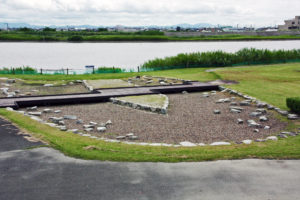Former Pattern Shop / Shipyard History Museum, in Nagasaki
This site is registered on UNESCO World Heritage as Japan’s Meiji Industrial
Revolution site in 2015.
The Former Pattern Shop was built in 1898 to produce wooden patterns for castings
and is the oldest factory building in the shipyard. It is a two-storied brick building with
a timber roof truss. There is a U-shaped rail on the ceiling to transport materials.
The building was refurbished to the Shipyard History Museum in 1985 and is open
to the public.
 |
 |
 |
Mietsu Naval Dock, in Saga
This site is registered on UNESCO World Heritage as Japan’s Meiji Industrial
Revolution site in 2015
Before Meiji Restoration, the Mietsu Naval Dock served as a venue for naval drilling
and maintenance of Western-style ship, as the naval base of Saga Clan. Japan’s first
practical steam ship, the Ryofu-maru was constructed there in 1865.
 |
 |
 |
Onga River Pump Station
This site is registered on UNESCO World Heritage as Japan’s Meiji Industrial
Revolution site in 2015
Built in 1910 on the east bank of the Onga River. It served, and still serves, to deliver
industrial water to Yawata via an 11.4 km pipeline. This supply is integral to the steel
production process and was necessary to cope with the 1st phase expansion of the
Imperial Steel Works.
|
|
|
|
First Head office of the Steel Works
This site is registered on UNESCO World Heritage as Japan’s Meiji Industrial
Revolution site in 2015.
The the building for the Head office of the Imperial Steel Works was constructed in 1899,
two years before commencement of Japan’s Steel Industry.
The design of the building is a harmony of European and Japanese architectural styles.
The construction of the structure below the roof is a European style and uses red bricks
for the outside walls.
Aiming to symbolize a Good future for Japan, the roof was designed with a traditional
Japanese triangular shape and Japanese tiles were used to complete the roof.
The building was initially used as a Head office until 1922, however with the expansion
of production facilities, the Head Office was moved to another place due to lack of space.
After that, the building was used for various purposes such as a Research and Developing
Center for Steel Products.
 |
 |
 |
 |
 |
 |
Shinbaru-Nuyama Mounded Tombs, in Fukutsu
The site has been registered on the UNESCO World Heritage as
the Sacred Island Okinoshiam and Associated site in the Munakata Region
The Tomb Group in Fukutsu City comprises the tombs of the Munakata clan, an ancient
powerful family that led interactions with overseas countries. The Munakata clan also
performed rituals on Okinoshima and nurtured the tradition of faith in in the sacred island.
 |
 |
 |



